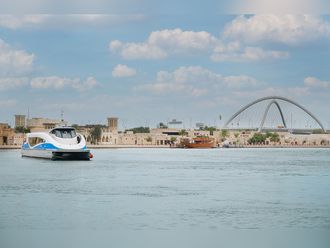The Middle East, particularly the Gulf, has long been a region characterised by high rates of population growth compared with any other region, even surpassing Sub-Saharan Africa.
In fact, the population growth rate in the Middle East and North Africa region is nearly twice that of East Asia and four times that of the world's high income nations.
The population growth rate in the region's six states has been among the highest in the world during the last few decades. Low mortality rates along with high fertility rates and the growing number of expatriates have contributed to such an increase.
Thus, growth rates reached a peak of three per cent around 1980, while the growth rate of the world as a whole reached its peak of two per cent more than a decade earlier.
But since 1990, the total fertility rate is estimated to have declined in the Gulf countries during a period of slightly more than one decade, decreasing by 1.2 births per woman in Bahrain, 0.8 births per woman in Kuwait, 0.9 births per woman in Qatar, 1.3 births per woman in Oman, 1.1 births per woman in Saudi Arabia, and 1.2 births per woman in the UAE, according to a World Health Report 2001 issued recently by WHO.
Despite the decline, fertility rates are still high in some Gulf countries. In 2000, Saudi Arabia and Oman had 5.7 and 5.8 births per woman respectively.
The rate of natural increase, that represents the population change based on birth and mortality rates regardless of migration, was estimated last year at 1.9 per cent in Bahrain , 1.8 per cent in Kuwait, 3.5 per cent in Oman , 2.7 per cent in Qatar, 2.9 per cent in Saudi Arabia and 1.4 per cent in the UAE.
In fact, among the Gulf countries, the UAE is considered to have the greatest proportion of elderly people, representing 5.1 per cent of the total population in 2000.
The relatively high dependency ratio (the ratio between the inactive population – representing those too young or too old to work - and the active population) has witnessed some changes during the last decade, decreasing by six per cent in Bahrain,11 per cent in Kuwait, three per cent in Qatar, eight per cent in Oman, one per cent in Saudi Arabia and five per cent in the UAE.
Life expectancy indicators for 2000 put Kuwait in the first position with the highest probability of life for both males and females with 74.2 and 76.8 years respectively, while Saudi Arabia has the lowest life expectancy indicator with 68.1 years for males and 73.5 years for females.
In order to determine the population trends in the Gulf, it is important to make a comparison with other chosen figures. For example, the annual growth rate during the last decade was 1.1 per cent in the United States, 0.3 per cent in Japan and Germany, 2.2 per cent in Bangladesh, 2.5 per cent in Cameroon, 1.8 per cent in India, 1.5 per cent in Indonesia and 3.1 per cent in Uganda.
However, according to the Report, a noticeable decline is perceived in the annual population growth rate in the Gulf countries during the last decade. Thus, the average annual growth rate between 1990 and 2000 is estimated at 2.7 per cent in Bahrain, 2.6 per cent in the UAE, 2.2 per cent in Qatar, 2.8 per cent in Saudi Arabia and 3.6 per cent in Oman, while the average annual growth observed in Kuwait between 1990 and 2000 was a negative -1.1 per cent.
The report also shows that the Gulf states experienced an appreciable decline in fertility between 1990 and 2000, with the total fertility rate decreasing from 3.7 births per woman in 1990 to 2.5 births in 2000 in Bahrain, from 3.6 births to 2.8 in Kuwait, from 4.4 births to 3.5 in Qatar, from 7 births to 5.7 in Oman, and from 6.9 births to 5.8 in Saudi Arabia. In the UAE, the total fertility rate decreased from 4.2 births to 3 births per woman.
In the rest of the world, the total fertility rate in 2000 was two births per woman in the U.S., 1.4 births in Japan and 1.3 births in Germany - which is well below the replacement level of 2.1 births per woman, 3.7 births per woman in Bangladesh, 4.9 births in Cameroon, 3.1 births in India, 2.4 births in Indonesia, and 7.1 births in Uganda.
Although projections depict a slowing of population growth, the region's population estimated at 30 million is expected to more than double by 2050.
As the Gulf's total population increases, so does its elderly population. According to the report, an increase in the percentage of the population aged 60 and above has been observed during the last decade.
In 1990, this category represented 3.8 per cent in Bahrain, 2.1 per cent in Kuwait , 2.1 per cent in Qatar , 3.8 per cent in Oman , 4.1 per cent in Saudi Arabia, and 2.5 per cent in the UAE.
In 2000, it increased to 4.7 per cent in Bahrain , 4.4 per cent in Kuwait, 3.1 per cent in Qatar, 4.2 per cent in Oman, 4.8 per cent in Saudi Arabia and 5.1 per cent in the UAE.
In comparison, also in 2000, this category of the population represented 16.1 per cent in the United States , 23.2 per cent in both Japan and Germany, 4.9 per in Bangladesh, 5.6 per cent in Cameroon, 7.6 per cent in both India and Indonesia, and 3.8 per cent in Uganda.
This factor has an important impact on the dependency ratio, with the region's economic dependency the highest in the world because of its large percentage of very young people and low levels of females in the labo












